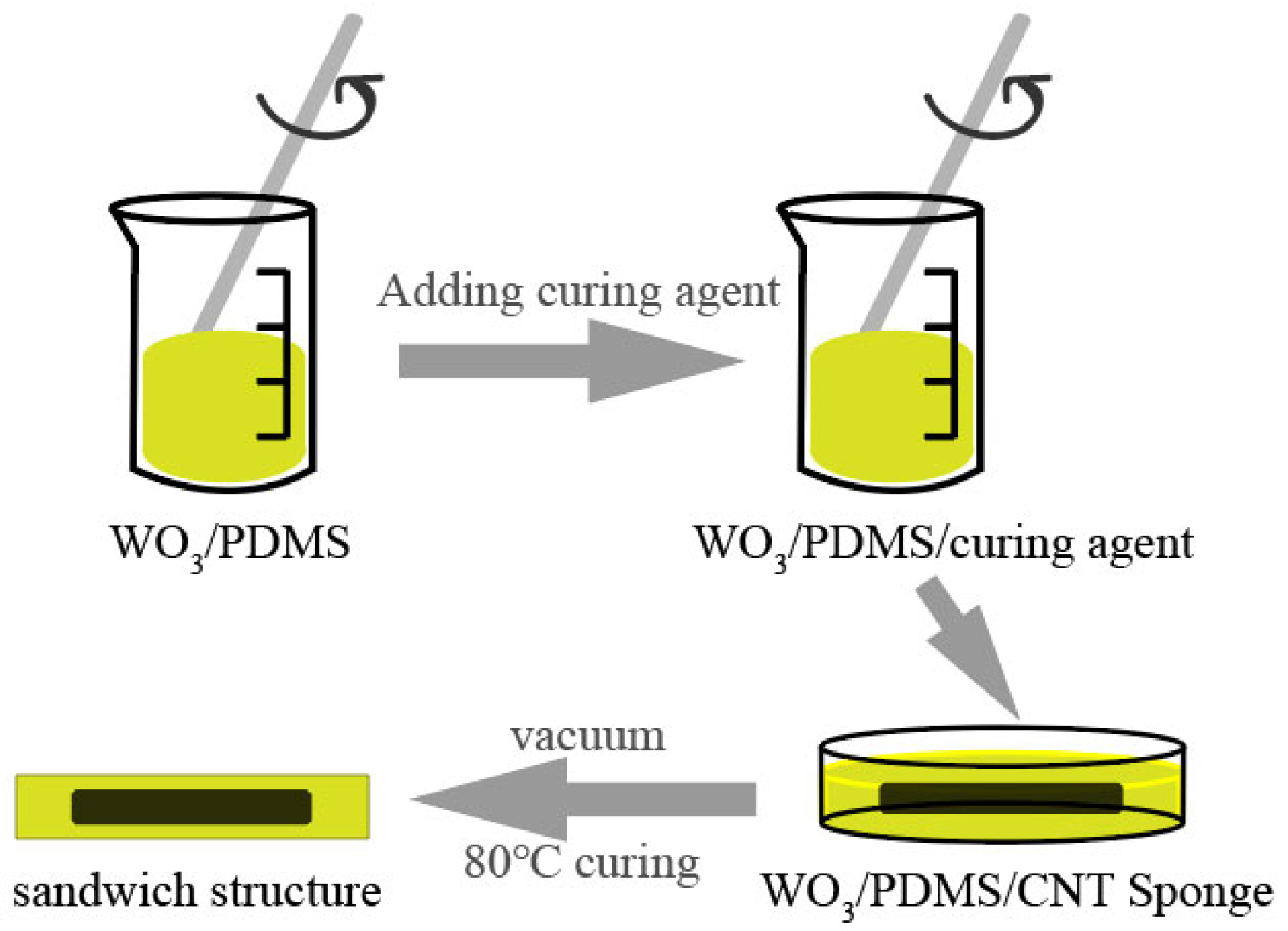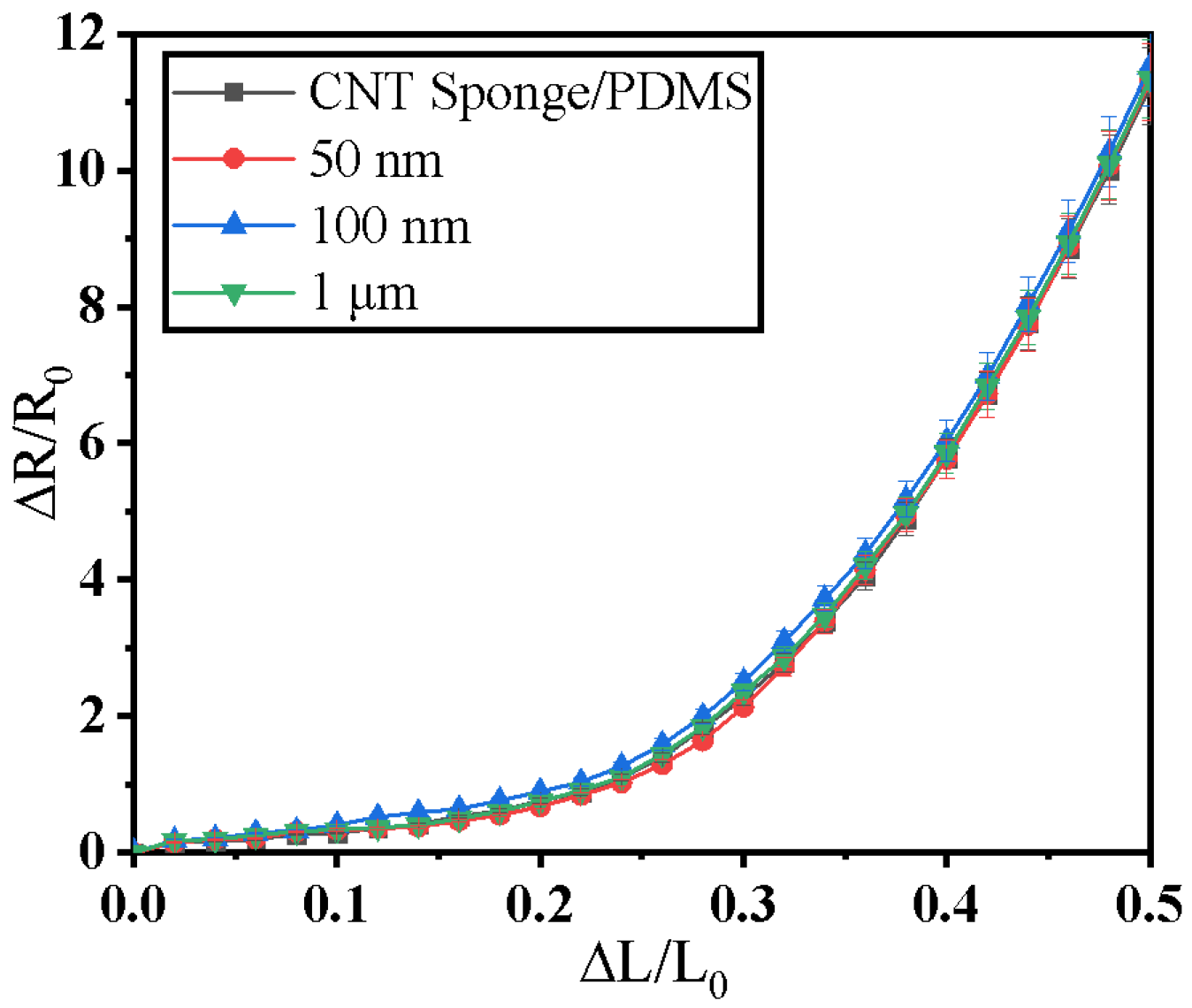Study on the Gamma Irradiation Characteristics of a Carbon Nanotube Sponge/Polydimethylsiloxane/Tungsten Oxide Flexible Force-Sensitive Structure
Abstract
:1. Introduction
2. Experimental
2.1. Materials
2.2. Structure Preparation
2.3. Experimental Conditions
3. Test Results
3.1. Force-Sensitive Performance under Different WO3 Particle Sizes
3.2. Force-Sensitive Performance after Irradiation with Different Doses
4. Conclusions
Author Contributions
Funding
Institutional Review Board Statement
Informed Consent Statement
Data Availability Statement
Conflicts of Interest
References
- Tsui, M.N.; Islam, M.F. Creep- and fatigue-resistant, rapid piezoresistive responses of elastomeric graphene-coated carbon nanotube aerogels over a wide pressure range. Nanoscale 2016, 9, 1128–1135. [Google Scholar] [CrossRef] [PubMed]
- Zhang, F.; Feng, Y.; Qin, M.; Ji, T.; Lv, F.; Li, Z.; Gao, L.; Long, P.; Zhao, F.; Feng, W. Stress-sensitive thermally conductive elastic nanocomposite based on interconnected graphite-welded carbon nanotube sponges. Carbon 2019, 145, 378–388. [Google Scholar] [CrossRef]
- Li, J.; Zhao, S.; Zeng, X.; Huang, W.; Gong, Z.; Zhang, G.; Sun, R.; Wong, C.P. Highly Stretchable and Sensitive Strain Sensor Based on Facilely Prepared Three-Dimensional Graphene Foam Composite. ACS Appl. Mater. Interfaces 2016, 8, 18954–18961. [Google Scholar] [CrossRef] [PubMed]
- Zhao, X.H.; Ma, S.N.; Long, H.; Yuan, H.; Tang, C.Y.; Cheng, P.K.; Tsang, Y.H. Multifunctional Sensor Based On Porous Carbon Derived from Metal-Organic Frameworks for Real Time Health Monitoring. ACS Appl. Mater. Interfaces 2018, 10, 3986–3993. [Google Scholar] [CrossRef]
- Lee, J.H.; Nam, Y.W.; Jung, H.C.; Baek, D.H.; Lee, S.H.; Hong, J.S. Shear induced CNT/PDMS conducting thin film for electrode cardiogram (ECG) electrode. Biochip J. 2012, 6, 91–98. [Google Scholar] [CrossRef]
- Netravali, A.N.; Manji, A. Effect of 60Co gamma radiation on the mechanical properties of epoxy blends and epoxy-graphite fiber interface. Polym. Compos. 1991, 12, 153–160. [Google Scholar] [CrossRef]
- Li, Z.; Nambiar, S.; Zheng, W.; Yeow, J.T.W. PDMS/single-walled carbon nanotube composite for proton radiation shielding in space applications. Mater. Lett. 2013, 108, 79–83. [Google Scholar] [CrossRef]
- Gao, Y.; Du, B.X.; Ma, Z.L.; Zhu, X.H. Decay behavior of surface charge on gamma-ray irradiated epoxy resin. In Proceedings of the IEEE International Conference on Solid Dielectrics, Potsdam, Germany, 4–9 July 2010. [Google Scholar]
- Suzuki, S.; Kobayashi, Y. Threshold Energy of Low-Energy Irradiation Damage in Single-Walled Carbon Nanotubes. Jpn. J. Appl. Phys. 2008, 47, 2040–2043. [Google Scholar] [CrossRef]
- Le, C.; Yan, Z.; Jian, L.Y.; Fang, J.; Ling, L.W. Study on the damage mechanism for epoxy resin under gamma irradiation. Thermosetting Resin 2016. [Google Scholar]
- Liu, K.; Yang, C.; Song, L.; Wang, Y.; Wei, Q.; Deng, Q.; Hu, N. Highly stretchable, superhydrophobic and wearable strain sensors based on the laser-irradiated PDMS/CNT composite. Compos. Sci. Technol. 2022, 218, 109148. [Google Scholar] [CrossRef]
- Li, L.; Bai, Y.; Li, L.; Wang, S.; Zhang, T. A superhydrophobic smart coating for flexible and wearable sensing electronics. Adv. Mater. 2017, 29, 1702517. [Google Scholar] [CrossRef] [PubMed]
- Phadke, A.; Zhang, C.; Arman, B.; Hsu, C.-C.; Mashelkar, R.A.; Lele, A.K.; Tauber, M.J.; Arya, G.; Varghese, S. Rapid self-healing hydrogels. Proc. Natl. Acad. Sci. USA 2012, 109, 4383–4388. [Google Scholar] [CrossRef] [PubMed] [Green Version]
- Li, T.; Li, L.; Sun, H.; Xu, Y.; Wang, X.; Luo, H.; Liu, Z.; Zhang, T. Porous ionic membrane based flexible humidity sensor and its multifunctional applications. Adv. Sci. 2017, 4, 1600404. [Google Scholar] [CrossRef] [PubMed]
- Al-Yousef, H.A.; Alotiby, M.; Hanfi, M.Y.; Alotaibi, B.M.; Mahmoud, K.A.; Sayyed, M.I.; Al-Hadeethi, Y. Effect of the Fe2O3 addition on the elastic and gamma-ray shielding features of bismuth sodium-borate glass system. J. Mater. Sci. Mater. Electron. 2021, 32, 6942–6954. [Google Scholar] [CrossRef]
- Rezaei-Ochbelagh, D.; Azimkhani, S. Investigation of gamma-ray shielding properties of concrete containing different percentages of lead. Appl. Radiat. Isot. 2012, 70, 2282–2286. [Google Scholar] [CrossRef] [PubMed]
- Mostafa, A.M.A.; Issa, S.A.M.; Sayyed, M.I. Gamma ray shielding properties of PbO-B2O3-P2O5 doped with WO3. J. Alloys Compd. 2017, 708, 294–300. [Google Scholar] [CrossRef]
- Limkitjaroenporn, P.; Kaewkhao, J.; Limsuwan, P.; Chewpraditkul, W. Physical, optical, structural and gamma-ray shielding properties of lead sodium borate glasses. J. Phys. Chem. Solids 2011, 72, 245–251. [Google Scholar] [CrossRef]
- Temir, A.; Zhumadilov, K.; Zdorovets, M.; Kozlovskiy, A.; Trukhanov, A. Study of gamma radiation shielding efficiency with radiation-resistant Bi2O3-TeO2-WO3 ceramics. Solid State Sci. 2021, 115, 106604. [Google Scholar] [CrossRef]
- Issa, S.; Rashad, M.; Hanafy, T.A.; Saddeek, Y.B. Experimental investigations on elastic and radiation shielding parameters of WO3-B2O3-TeO2 glasses. J. Non-Cryst. Solids 2020, 544, 120207. [Google Scholar] [CrossRef]
- Dong, M.; Xue, X.; Yang, H.; Liu, D.; Wang, C.; Li, Z. A novel comprehensive utilization of vanadium slag: As gamma ray shielding material. J. Hazard. Mater. 2016, 318, 751–757. [Google Scholar] [CrossRef]
- Yun-Bo, L.I.; Huang, X.Y.; Yang, J.; Sun, Y.T.; Zhuo, M.C.; Zhu, Y.B. Investigation on X-ray Shielding Property of PA6 Composite with High Tungsten Content. China Plast. Ind. 2011, 39, 49–51. [Google Scholar]
- Sharaf, J.M.; Hamideen, M.S. Photon attenuation coefficients and shielding effects of Jordanian building materials—ScienceDirect. Ann. Nucl. Energy 2013, 62, 50–56. [Google Scholar] [CrossRef]
- Kim, J.; Seo, D.; Lee, B.C.; Seo, Y.S.; Miller, W.H. Nano-W Dispersed Gamma Radiation Shielding Materials. Adv. Eng. Mater. 2014, 16, 1083–1089. [Google Scholar] [CrossRef]





| Material | Function | Reference |
|---|---|---|
| Graphene-coated carbon nanotube aerogels | Resistance to creep and fatigue | [1] |
| Graphene foam (GF)/PDMS | Highly stretched and sensitive | [3] |
| Laser-irradiated PDMS/CNT composite | Superhydrophobic | [11] |
| MWCNT/TPE composite film coatings | Superhydrophobic smart coating | [12] |
| Hydrogels | Rapid self-healing | [13] |
| CNT sponge/PDMS/WO3 | Gamma irradiation resistance | This work |
Publisher’s Note: MDPI stays neutral with regard to jurisdictional claims in published maps and institutional affiliations. |
© 2022 by the authors. Licensee MDPI, Basel, Switzerland. This article is an open access article distributed under the terms and conditions of the Creative Commons Attribution (CC BY) license (https://creativecommons.org/licenses/by/4.0/).
Share and Cite
Han, X.; Li, X.; Wang, R.; Liu, J.; Liu, L. Study on the Gamma Irradiation Characteristics of a Carbon Nanotube Sponge/Polydimethylsiloxane/Tungsten Oxide Flexible Force-Sensitive Structure. Micromachines 2022, 13, 1024. https://doi.org/10.3390/mi13071024
Han X, Li X, Wang R, Liu J, Liu L. Study on the Gamma Irradiation Characteristics of a Carbon Nanotube Sponge/Polydimethylsiloxane/Tungsten Oxide Flexible Force-Sensitive Structure. Micromachines. 2022; 13(7):1024. https://doi.org/10.3390/mi13071024
Chicago/Turabian StyleHan, Xingcheng, Xin Li, Ruirong Wang, Jinping Liu, and Lishuang Liu. 2022. "Study on the Gamma Irradiation Characteristics of a Carbon Nanotube Sponge/Polydimethylsiloxane/Tungsten Oxide Flexible Force-Sensitive Structure" Micromachines 13, no. 7: 1024. https://doi.org/10.3390/mi13071024
APA StyleHan, X., Li, X., Wang, R., Liu, J., & Liu, L. (2022). Study on the Gamma Irradiation Characteristics of a Carbon Nanotube Sponge/Polydimethylsiloxane/Tungsten Oxide Flexible Force-Sensitive Structure. Micromachines, 13(7), 1024. https://doi.org/10.3390/mi13071024






